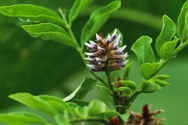
Photo © Steven Foster
Introduction
Licorice is native to the Mediterranean, central to southern Russia, and Asia Minor to Iran, now widely cultivated throughout Europe, the Middle East, and Asia.1 It is a perennial with aggressive laterally spreading roots and loose spikes of pale blue to violet pea flowers in summer.2 The root is the most commonly used plant part and can be harvested after 3 to 4 years of growth.1 History and Cultural Significance
Dioscorides, a first century Greek physician, coined the species name which is derived from a combination of Greek words, glukos meaning sweet and riza meaning root.1 Modern research discovered that one of the main constituents of the root is glycyrrhizin (also known as glycyrrhizic or glycyrrhizinic acid) which is 50 times sweeter than sugar.1 The Romans changed glycyrrhiza to liquiritia which over the years evolved into licorice.3 Until 1000 CE, licorice was mainly collected in the wild.1 Large scale cultivation did not occur until the late 1550s.2 Ancient Arabian cultures used licorice to treat coughs and relieve constipation.1 Theophrastus, an ancient Greek scientist, documented the use of licorice to assist with coughs and asthma. Since 25 CE, Chinese cultures have used the herb extensively to relieve cough and as an expectorant. It also has been used to relieve spasms of the stomach muscles. Licorice has a long history as a common remedy in Ayurvedic medicine for its expectorant, anti-inflammatory, and laxative properties.The German Commission E approved licorice root for inflammations of the upper respiratory tract and stomach ulcers.1 Licorice root is sold in capsules, tablets, tinctures, and other dietary supplements for its traditional uses. It is used as a food flavoring in candy, cakes, ice cream and packaged desserts.3 Most of the candy sold in the US today as licorice is flavored with a synthetic licorice or anise.3 A large amount of imported natural licorice is used to flavor tobacco products.1 Licorice extracts are used in cough drops, syrups, laxatives, and nicotine lozenges.4 The root is also added to teas. Modern Research
Licorice is one of the most extensively researched medicinal and food plants.1 Studies on licorice have demonstrated positive effects for treatment of various types of ulcers.5 Others showed that dietary consumption of licorice root extract may help to lower cholesterol and act as an antioxidant.5,6 Future Outlook
The selection of the correct species of licorice for cultivation is a major concern.7 The replacement of species with seeds from species that are related is common in modern plant commerce. For example, large tracts of the world market of G. glabra root are actually G. uralensis.7 Licorice, like many herbs that are produced commercially, is often grown in developing countries where labor is not as costly and chemicals are not used due to prohibitive cost. Thus the raw material from these countries is relatively inexpensive and free of synthetic chemicals.8 In more developed countries, licorice is sometimes grown in fields that have been treated with herbicides which would not be acceptable for those only wanting to use organically grown herbs.9 As seed germination and seedling growth are slow, commercial propagation of licorice by cuttings from the roots (stolons) is preferable.10 This allows for quicker growth and a crop that is ready for harvesting in 3-4 years. Small plantings are being established in Australia10 and New Zealand9 but accurate information of the commercial potential of these crops is not yet available. References
1 Blumenthal M, Goldberg A, Brinckmann J, editors. Herbal Medicine: Expanded Commission E Monographs. Austin, TX: American Botanical Council; Newton, MA: Integrative Medicine Communications; 2000. 2 Bown D. The Herb Society of America New Encyclopedia of Herbs & Their Uses. New York: DK Publishing, Inc.; 2001. 3 Onstad D. Whole Foods Companion. White River Junction, VA: Chelsea Green Publishing Co.; 1996. 4 Leung AY, Foster S. Encyclopedia of Common Natural Ingredients Used in Foods, Drugs, and Cosmetics. New York: John Wiley and Sons; 1996. 5 Blumenthal M, Hall T, Goldberg A, Kunz T, Dinda K, Brinckmann J, et al, editors. The ABC Clinical Guide to Herbs. Austin, TX: American Botanical Council; 2003. 6 Fuhrman B, et al. Antiatherosclerotic Effects of Licorice Extract Supplementation on Hypercholesterolemic Patients: Increased Resistance of LDL to Atherogenic Modifications, Reduced Plasma Lipid levels, and Decreased Systolic Blood Pressure. Nutrition. 2002:18;268-273. 7 Schmidt M, Thomsen M, Betti G. WHO Releases “Guidelines on Good Agricultural and Collection Practices” of Herbs. HerbalGram. 2005;65:22-24. 8 Division of Markets: Entrepreneurial Catalog. Licorice. Available at: http:www.ag.state.co.us/mkt/entrepreneurial%20catalog/crops.html. Accessed March 12, 2005. 9 Growing Licorice. New Zealand Institute for Crop & Food Research Ltd. Available at: http://www.crop.cri.nz/home/products-services/publications/broadsheets/121-Licorice.pdf. Accessed March 12, 2005. 10 Shipard I. Licorice: an absolutely delicious crop. The Australian New Crops Newsletter. July 1996
|